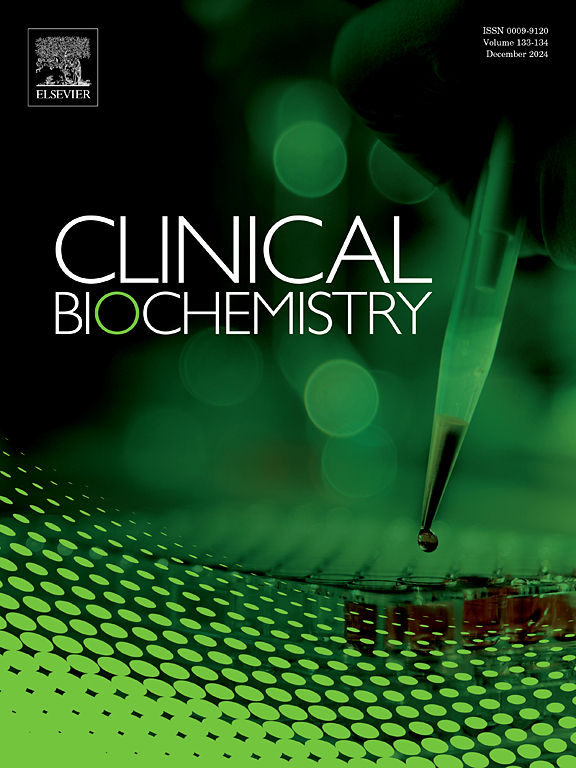评估高甘油三酯、甘油三酯-葡萄糖指数(TyG)和TG/HDL比值在20 年随访期间对心血管疾病和死亡率的预测价值:德黑兰脂质和葡萄糖研究
IF 2.5
3区 医学
Q2 MEDICAL LABORATORY TECHNOLOGY
引用次数: 0
摘要
目的:心血管疾病(CVD)仍然是全球发病率和死亡率的主要原因,受到包括脂质紊乱和胰岛素抵抗(IR)在内的危险因素的复杂相互作用的影响。甘油三酯-葡萄糖(TyG)指数和甘油三酯与高密度脂蛋白胆固醇(TG/HDL)比值已成为评估心血管风险的潜在指标。本研究旨在评估伊朗人群中高甘油三酯血症、TyG指数和TG/HDL比值对死亡率和心血管疾病发生的预测价值。设计和方法:在德黑兰脂质和葡萄糖研究中进行了20 年的研究,该研究分析了7,117名参与者,以评估这些脂质生物标志物与心血管疾病风险和死亡率之间的关系。根据他们的TyG和TG/HDL指数对参与者进行分层,Cox比例风险模型确定了考虑各种人口统计学和临床变量的三个调整模型的风险比。结果:研究发现,在20年随访期间,甘油三酯、TyG和TG/HDL水平升高与死亡率和心血管疾病风险增加之间存在显著关联。具体来说,CVD事件的风险比在第二甘油三酯组(150-250 mg/dL)中非常显著,模型1和模型2的风险比为1.36(1.19-1.55),而在第三组(250-400 mg/dL)中,模型1的风险比为1.88(1.63-2.17),模型2的风险比为1.90(1.65-2.19),模型3的风险比为1.44(1.24-1.67)。结论:高甘油三酯血症、TyG指数、TG/HDL比值是一种易于计算和临床相关的心血管风险评估指标。将其纳入常规健康评估可促进高危个体的早期发现和管理,从而有可能减少心血管疾病在社区中的发病率和影响。本文章由计算机程序翻译,如有差异,请以英文原文为准。
Assessing the predictive value of elevated triglycerides, triglyceride-glucose index (TyG), and TG/HDL ratios for cardiovascular disease and mortality during 20 years of follow-up: Tehran lipid and glucose study
Objectives
Cardiovascular disease (CVD) remains a leading cause of morbidity and mortality globally, influenced by a complex interplay of risk factors including lipid disorders and insulin resistance (IR). The triglyceride-glucose (TyG) index and the triglyceride to high-density lipoprotein cholesterol (TG/HDL) ratio have emerged as potential indicators for assessing cardiovascular risk. This study aimed to evaluate the predictive value of hypertriglyceridemia, the TyG index, and the TG/HDL ratio for mortality and CVD occurrence within an Iranian population.
Design and methods
Conducted within the Tehran Lipid and Glucose Study over 20 years, this research analyzed 7,117 participants to assess the association between these lipid biomarkers and CVD risk and mortality. Participants were stratified by their TyG and TG/HDL indices, with Cox proportional hazards models determining risk ratios across three adjusted models considering various demographic and clinical variables.
Results
The study found significant associations between elevated triglycerides, TyG, and TG/HDL levels with increased risks of mortality and CVD during the 20-year follow-up. Specifically, the hazard ratios for CVD events were notably significant in the second triglyceride group (150–250 mg/dL), with a hazard ratio of 1.36 (1.19–1.55) in both Model 1 and Model 2, and in the third group (250–400 mg/dL), with ratios of 1.88 (1.63–2.17) in Model 1, 1.90 (1.65–2.19) in Model 2, and 1.44 (1.24–1.67) in Model 3.
Conclusion
Hypertriglyceridemia, the TyG index, and the TG/HDL ratio are easily calculable and clinically relevant markers for cardiovascular risk assessment. Their integration into routine health evaluations could facilitate early detection and management of at-risk individuals, potentially reducing the incidence and impact of CVD within the community.
求助全文
通过发布文献求助,成功后即可免费获取论文全文。
去求助
来源期刊

Clinical biochemistry
医学-医学实验技术
CiteScore
5.10
自引率
0.00%
发文量
151
审稿时长
25 days
期刊介绍:
Clinical Biochemistry publishes articles relating to clinical chemistry, molecular biology and genetics, therapeutic drug monitoring and toxicology, laboratory immunology and laboratory medicine in general, with the focus on analytical and clinical investigation of laboratory tests in humans used for diagnosis, prognosis, treatment and therapy, and monitoring of disease.
 求助内容:
求助内容: 应助结果提醒方式:
应助结果提醒方式:


